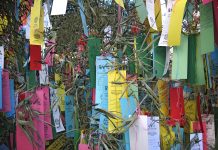Imbolc is a pagan holiday, usually celebrated on the eve of February 1 and into February 2 in Ireland and Scotland. In the Middle Ages, its association may have been with the goddess Brigid (later Christianized as St. Brigid). Brigid is the Gaelic goddess of poetry, healing and smithcraft. In the Christian calendar, the holiday is now called Candlemas.
Both pagans globally and Christian communities in Scotland and Ireland celebrate St. Brigid’s day (for Christians) or Imbolc (pagans). It’s a feast day that represents the darkest hour of winter that comes before the dawning of spring. Lighting fires in the hearth and lighting and making candles (often by pouring paraffin into the snow to form “snow candles”) are activities of Imbolc. The lighting of candles and fires represents the return of the sun’s warmth over the next months. To commemorate the lactation of ewes pregnant with spring lambs, milk-based treats, such as custards, are popular during Imbolc.
Motifs for crafts common to St. Brigid’s Day/Imbolc can use straw to make St. Brigid’s crosses. Also common are Brigid dolls—and even little beds for these dolls—to lay by the fire on Imbolc Eve, to welcome St. Brigid’s presence, who arrives to walk the earth on Imbolc eve. On Imbolc day, girls carry these dolls from door to door and receive little gifts of coins or snacks. An acorn-tipped “magic wand” and a Brigid’s crown (with flower buds and light-emitting diodes (LEDs)!) would be appealing to little ones who wish to evoke the magic of spring’s arrival.
Finally, Imbolc is traditionally a time of weather forecasting, with the custom of watching to see if a snake or badger comes out of its hole, which is likely a precursor to the North American Groundhog Day.



































